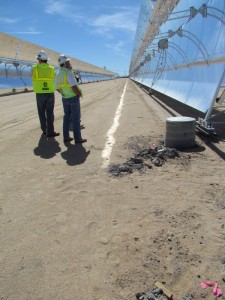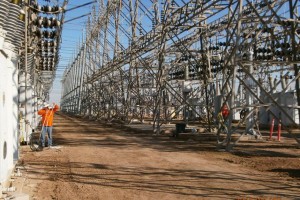All solar projects — big and small — need to be designed, built and run to comply with all codes and regulations. Third-party certification authorities can ease the many processes.
By Kevin Wedman and Shannon Hunter
Solar power projects are on the rise around the globe, fueled by the growing need for commercial and residential energy and the market preference for energy from renewable sources. In the United States alone, the Solar Energy Industries Association (SEIA) estimates that the country’s share of global solar installations is currently nearing 13 percent, an increase of 5 percent since 2008 (according to U.S. Solar Market Insight from Q2 2013). A new solar project will soon be installed every four minutes in the United States, on average.
 Achieving Code Compliance
Achieving Code Compliance
To meet the growing demand for solar power, project developers have to navigate an increasingly complicated set of construction and operational challenges, which include more stringent regulatory conditions, tighter construction schedules and constraints in the availability of personnel, resources and equipment. If these challenges are not properly addressed early, the developer can expect to face project delays and cost overruns. For utility-scale projects, budgets of more than $1 billion are not uncommon. A delay of even a few days on a project of this size and scope can easily translate to unplanned costs of several millions of dollars.
But whether a solar project is designed to generate 5 or 500 MW of power, developers need to ensure that their plants are designed, built and run to comply with all applicable federal, state and local codes for safety, environment, fire, structural integrity and energy efficiency. At the same time, inspections and code compliance services must be carried out as safely, cost-effectively and reliably as possible.
In the state of California, which is home to many of the largest solar projects in operation or development, utility-scale projects are primarily built on public lands. The federal Bureau of Land Management (BLM) recently enacted a Programmatic Environmental Impact Statement, which pre-approves public land for the development of large-scale solar projects, all over the southwestern United States. Many of these projects will be in operation for 25 years or more, which is beyond the scope of many regulatory agencies’ experience.
These new projects also share some common challenges that are unique to operating in California, which include rigorous structural standards that allow them to withstand earthquakes and reliably provide power to surrounding communities after an earthquake. In addition, many of these projects are located in remote desert locations, hundreds of miles from some of the communities they serve. Thus, the transmission grid from the plant to the end-user must be certified for reliable and continuous operation.
Independent third-party certification bodies are increasingly called upon to ensure that a new project is designed and built to the proper specifications and that it complies with guidelines that safeguard environmental, biological, safety and cultural interests in the vicinity. Selecting the right certification provider requires careful consideration of several criteria that must be met to ensure project success.
 Comprehensive Selection Criteria
Comprehensive Selection Criteria
Any qualified third-party certification authority should first come equipped with a thorough understanding of all relevant building, operational and environmental compliance codes at the municipal, state and federal levels. In addition, they should be able to provide guidance on how the developer can comply with these codes in ways that are not too expensive or onerous.
A third-party certification body should also provide full-time, on-site support during the commissioning and ramp-up stages of a project. This availability is critical for inspections, for example, as having the third party on site helps the operator avoid delays associated with waiting for an offsite inspector from the local municipality. If any part of the facility is flagged during the inspection, it can be addressed and re-inspected by the third party in a shorter timeframe. This full-time third-party presence may also provide the necessary qualified manpower during project building and startup; the developer can avoid the need to staff up internally during the initial stages of the project, only to lay off people once the project is up and running.
An effective third-party certification partner should follow a consistent certification approach that ensures robust quality assurance/quality control (QA/QC) for the project, both at startup and during ongoing operation. This is aided by efficient processes to control costs, schedules and documentation. Bureau Veritas, for example, employs its Compliance Document Tracking System, an electronic document creation and archiving system that keeps all relevant inspection, permit application and regulatory compliance documents for a project in a safe, password-protected environment. All parties, from owners to regulatory agencies to compliance managers, can access and update all documents, which helps ensure that important project milestones are not missed and that the inspection and permit application process occurs as seamlessly as possible.
A particular benefit of working with a larger certification provider is the greater operating reach and breadth of expertise that they can provide. A large organization provides local expertise to assist in projects in the communities in which their certification experts live and work. In addition, they should be able to offer a nationwide reach, whereby personnel can network with their associates working on other solar projects across the country to offer advice and share best practices.
A developer should also consider a third-party certifier’s experience, integrity and ethics during the selection process. Certification providers that pride themselves on conducting their inspections and certifications with the highest level of integrity and ethics will in turn yield favorable business opportunities for the project developer. Partnering with an established third party with a long successful track record provides developers with added assurance that they will be around to offer consulting and assistance through the 25-plus year operating life of a project.
Proven Field Results
Bureau Veritas has provided regulatory and certification assistance to power projects for decades. The certification program has evolved over time to provide the necessary technical expertise and regulatory understanding required for these larger and longer-lived projects, which was a major influencer in BLM’s decision to partner with Bureau Veritas for several high-profile projects currently under construction in the Southwest. The California Energy Commission selected the certification provider to act as the Delegate Chief Building Official (DCBO) for a 377-MW solar complex (Ivanpah) in the California desert and set for completion in late 2013. Bureau Veritas is also DCBO for a 250-MW solar trough project in the Sonoran Desert that is currently in the compliance phase.
This program was valuable in the design and construction of the Abengoa Mojave Solar Project, a 250-MW project in the California Mojave Desert operated by Spanish power provider Abengoa Solar. The company did not have the local construction and regulatory compliance experience in California and were manufacturing project components in Spain and shipping to the United States.
Bureau Veritas provided assurances that the project was built in compliance with all applicable codes and standards, and that the integrity of the project was not compromised during the design, execution and acceptance phases. This process began with an inspection of the manufacturing facilities and the individual components in Spain to ensure that they complied with federal and California regulations and the specifications of the project prior to shipment overseas. This inspection, conducted by in-country Bureau Veritas representatives, helped mitigate any adverse operational risks to the asset and avoided project delays associated with faulty or inadequate parts.
Many of the materials were then shipped to the project site in Bureau Veritas-inspected shipping containers, and once they arrived in California, the local certification teams reviewed the engineering documents and inspected the assembly process to ensure that they complied with approved plans and specifications per California Codes and Standards.
The inspectors also reviewed all safety protocols and provided safety officer services and fire plan review, safety and inspection services. In addition, Bureau Veritas assisted in the entire document review and control process and provided an archive of all completed work fulfilling technical requirements.
This comprehensive effort not only ensured that the project was completed safely and to code, but that it was done in a way that minimized time, costs and paper waste. These tangible benefits have been realized in several projects that employed Bureau Veritas as the inspection and certification provider. One developer of a large solar power project stated that this process provided cost and time savings that were seven times greater than its inspection fee.
As long-term solar power projects such as these become more common, the need for well-qualified, experienced and highly technical certification and inspection providers will become more crucial. Partnering with the right provider helps ensure that solar power projects of any size and complexity are designed, built and operated safely and cost-effectively — from startup to shutdown, many years down the line.
Kevin Wedman is national vice president and Shannon Hunter is marketing manager, both in the power and utilities division of Bureau Veritas, a global testing, inspection and certification company.
— Solar Builder magazine
[source: http://www.solarbuildermag.com/featured/certifcation-bureau-veritas/]

Leave a Reply
You must be logged in to post a comment.